 |
La Mer ("The Sea") is not only the title of Debussy's orchestral masterwork, but an apt metaphor for his innovative art.  As Rachel Carson noted, like the sea itself, the surface of Debussy's music hints at the brooding mystery of its depths, and ultimately the profound enigma of life itself – after all, mankind carries the primordial salt of the sea in our blood. As Rachel Carson noted, like the sea itself, the surface of Debussy's music hints at the brooding mystery of its depths, and ultimately the profound enigma of life itself – after all, mankind carries the primordial salt of the sea in our blood.
Debussy was an ideal guide for exploration into such musical depths, as he had no formal education and was able to sidestep tradition to absorb and apply a diverse and wide-ranging set of influences.  Among those which he acknowledged and others would later cite as key elements in his music: Among those which he acknowledged and others would later cite as key elements in his music:
- Bach's tracing and ornamenting of musical lines rather than melodic focus.
- The "infinite arabesques" and complex counterpoint of the Javanese gamelan (which he first heard at the 1889 Universal Exposition in Paris).
- The grace, suppleness and extended harmonic range of Chopin, a favorite of his first piano teacher.
- The stylization of nature in Japanese landscape prints (one of which, Hokusai's "The Hollow of the Wave off Kanagawa," he had in his studio and a portion of which graced the cover of the La Mer score).
- The oriental influences of Russian composers (to whom Debussy was exposed when he spent two summers tutoring the children of Tchaikovsky's patron, Mme. Van Meck).
- The spontaneity and freedom from arid formulas of Mussorgsky, whose art he viewed as "successive minute touches mysteriously linked together by means of an instinctive clairvoyance."
- The structures founded in terms of orchestral color of Strauss (Richard, not the Waltz King).
Debussy is often called a musical Impressionist, invoking an analogy to the emerging trend in French painting in which, in Paul Henry Lang's pithy phrase, the how dominates the what.  As Lang and Jonathan Kramer noted, much as earlier painters used color and light to illuminate realistic objects, musicians' textures had always served to articulate or enrich their melodic, harmonic or rhythmic structures, but Debussy was the first composer to create music of sheer sonority that simply was allowed to exist, without constantly having to progress toward a prescribed goal. As David Ewen put it, for Debussy color, nuance, mood, atmosphere and sensation were far more significant than drama or realism – his music is intended to appeal to the senses, not the intellect. As Lang and Jonathan Kramer noted, much as earlier painters used color and light to illuminate realistic objects, musicians' textures had always served to articulate or enrich their melodic, harmonic or rhythmic structures, but Debussy was the first composer to create music of sheer sonority that simply was allowed to exist, without constantly having to progress toward a prescribed goal. As David Ewen put it, for Debussy color, nuance, mood, atmosphere and sensation were far more significant than drama or realism – his music is intended to appeal to the senses, not the intellect.
Debussy chafed at the comparison with the Impressionist painters, since his work was far less representational (although perhaps he would have felt differently had he known the very late works of Cezanne and Monet, in which their subjects are far less apparent). Indeed, by its very nature music is abstract, free from the realistic imagery to which the visual arts are inexorably tied. Rather, he aligned himself with the Symbolist poets, who reveled more in the sound of words than in their actual meaning, and sought to suggest reality through a dream-world of metaphor and symbol.
Yet, the analogy to painting is valid – like the Impressionists, Debussy conjured his imagery not in a sonic blur but from seemingly disparate but carefully arranged flecks – move close to any Impressionist painting and the misty atmosphere ripens into a mosaic of intensely colored fragments. And, like the Impressionists, Debussy's work suggests open-air sketches in its seeming naturalness and spontaneity, and its inspiration in nature. 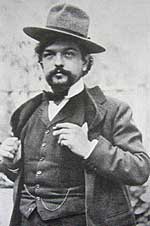 Debussy wrote: "There is nothing more musical than a sunset," counseled would-be composers to "listen to the wind," and found the piping of a shepherd to have more complex harmonies than any musical text. Indeed, he derided most music as "invented by frigid imbeciles riding on the backs of the Masters" – derivative attempts to mimic out-worn formulas only fit for the feeble-minded – and chided musicians for reading too many treatises and too seldom the book of nature. Debussy wrote: "There is nothing more musical than a sunset," counseled would-be composers to "listen to the wind," and found the piping of a shepherd to have more complex harmonies than any musical text. Indeed, he derided most music as "invented by frigid imbeciles riding on the backs of the Masters" – derivative attempts to mimic out-worn formulas only fit for the feeble-minded – and chided musicians for reading too many treatises and too seldom the book of nature.
Debussy's vision first emerged in his 1894 Prélude à l'après-midi d'un faune, an exquisitely colorful ten-minute mystical evocation of languid erotic longings on a sultry afternoon. A dreamy blend of memory and desire inspired by an 1876 poem by Stéphane Mallarmé (who, ironically, had stated that his aim was to emulate music), its slivers of melody flit within smooth but constantly shifting instrumental textures, a spontaneous triumph of artistic inspiration over established order that defies description or formal analysis. The Prélude seems weightless yet leaves an indelible imprint. It has often been remarked that its meandering opening flute solo breathed new life into the art of music. In retrospect, the Prélude is one of the true turning points in the history of aesthetics.
Debussy was fascinated by the sea, which he first depicted in the final Sirènes movement of his 1899 Nocturnes, in which 16 women's voices wordlessly depict the allure of the mythological temptresses amid undulating waves – a monochromatic mood, and a rather clear portrayal of the title characters and setting. La Mer was more evocative and less literal, perhaps in part because Debussy wrote it in landlocked Burgundy,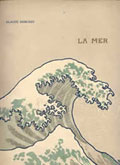 distilling memories of his childhood and holidays at the shore into an intense vision of the essence of the sea rather than a mere portrait. He wrote to a friend, "I have an endless store of memories [that] are worth more than the reality, whose beauty often deadens thought." Carson claims that Debussy felt overwhelmed in the presence of the sea and could not compose within sight or sound of it. distilling memories of his childhood and holidays at the shore into an intense vision of the essence of the sea rather than a mere portrait. He wrote to a friend, "I have an endless store of memories [that] are worth more than the reality, whose beauty often deadens thought." Carson claims that Debussy felt overwhelmed in the presence of the sea and could not compose within sight or sound of it.
In La Mer, the full scope of Debussy's remarkable art is on display. As Lang notes, it's "a vibrating, oscillating, glimmering sound complex, caressing the senses" in which the vast orchestral resources are rarely massed, but rather handled with delicacy and resourcefulness to "shimmer in a thousand colors." Thus, Debussy divides his strings into up to a dozen separate lines, combines the sonorities of disparate instruments, violates accepted rules of harmony with parallel chordal movement and unresolved progressions, and toys with thematic fragments that never coalesce into full-blown melodies, all to achieve unprecedented, yet wholly natural, sonorities and timbres. Pierre Boulez calls the result "an infinitely flexible conception of acoustical instrumental relationships" that avoided symmetry, "a development conceived in feelings and irreducible to a formal classical plan."
Debussy subtitled La Mer "Trois esquisses symphoniques" ("Three symphonic sketches"). Many commentators refer to it as a symphony, yet it deliberately shuns the essential structure and developmental focus of that genre. Indeed, Its three movements bear specific titles – "De l'aube à midi sur la mer" ("From dawn to noon on the sea"), "Jeux de vagues" ("Play of the waves") and "Dialogue du vent et de la mer" ("Dialog of the wind and the sea"). The first begins in inchoate mystery, the second suggests lively motion, and the third conjures the interplay of powerful forces. Yet, to the frustration of those inured to the schematic literalism of the popular tone poems of the time, it's impossible to assign a specific program. Thus, the shimmering, vibrant, imposing climax of the first movement could just as easily be a stiff breeze, clouds dispersing, sun penetrating the depths, or the appearance of a great ship. When Debussy's friend Erik Satie quipped that he liked the part at 11:15, he was deriding the title of the first movement, rather than the wholly evocative music.
Indeed, the entire work conjures moods and feelings evoked by the sea and defies classification. Saint-Saëns said "Debussy has not created a style but has cultivated the absence of style." Boulez remarked: "What was overthrown was not so much the art of development as the very concept of form itself, … giving wings to a supple, mobile expressiveness, … a miracle of proportion, balance and transparency." Or, in Debussy's own words: "There is no theory. You merely have to listen. Pleasure is the law."
In retrospect, Lang credited Debussy with a refreshing harmony of feeling and intellect, reflecting the restless and complicated mentality of the turn of the century without the whipped-up passions and tearful sentimentalism that marked much of the period's art. 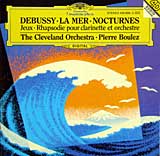 Perhaps that thwarting of convention helps explain the divergent views of contemporary French critics following the first performance of La Mer in December 1905. Jean Marnold praised the blend of its grandeur and delicacy and the weaving of shimmering colors into a fascinating polyphonic tissue. Louis Laloy vaunted the maturity of Debussy's concise, classical organization of the former art of suggestion, nuance and allusions into an intentionally incomplete work. M. D. Calvacoresi similarly praised the stronger colors, more definite lines and more robust inspiration that condensed and clarified the sum total of Debussy's discoveries. Others, though, were less enchanted. Pierre Lalo, critic of the influential le Temps, found it too studied, with nothing to do with the sea. Jean Chantavonic, while praising its evocative qualities, found it superficial and incoherent. Jean d'Voline felt the rhythm elementary and insipid. Michael Stegemann attempts to reconcile the two views, seeing La Mer as Debussy's attempt to meet his traditionalist critics part-way with clearer structures than prolonged nuances, more color than symbolism and more statements than suggestions. Perhaps that thwarting of convention helps explain the divergent views of contemporary French critics following the first performance of La Mer in December 1905. Jean Marnold praised the blend of its grandeur and delicacy and the weaving of shimmering colors into a fascinating polyphonic tissue. Louis Laloy vaunted the maturity of Debussy's concise, classical organization of the former art of suggestion, nuance and allusions into an intentionally incomplete work. M. D. Calvacoresi similarly praised the stronger colors, more definite lines and more robust inspiration that condensed and clarified the sum total of Debussy's discoveries. Others, though, were less enchanted. Pierre Lalo, critic of the influential le Temps, found it too studied, with nothing to do with the sea. Jean Chantavonic, while praising its evocative qualities, found it superficial and incoherent. Jean d'Voline felt the rhythm elementary and insipid. Michael Stegemann attempts to reconcile the two views, seeing La Mer as Debussy's attempt to meet his traditionalist critics part-way with clearer structures than prolonged nuances, more color than symbolism and more statements than suggestions.
Removed from the artistic ferment of Paris, the conservative views of Americans were uniformly disparaging. The New York critics found La Mer "a putrified mud-puddle," "unintelligible," "persistently ugly," "bewildering chaos," "a dissonant jumble" and "the dreariest kind of rubbish." A Boston wag thought it should be titled "Mal de Mer" ("Seasick"), with its movements devoted to Headache, Doubt and Nausea. Debussy seemed unfazed, responding to one critic that "you love and defend traditions that no longer exist for me. … The dust of the past is not always to be respected."
But some of the vituperation had a less rarified source than aesthetics. 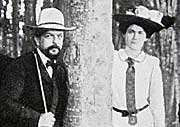 The previous year, Debussy had abandoned Lily, a simple dressmaker and his deeply devoted wife, for the wealthy older wife of a prominent banker (and who also had been the mistress of fellow-composer Gabriel Fauré). Lily shot herself, nearly all his friends turned against him, and society recoiled to uphold its standards of decency. As Louis Laloy remarked, the public made the artist pay dearly for the wrongs of the man. The previous year, Debussy had abandoned Lily, a simple dressmaker and his deeply devoted wife, for the wealthy older wife of a prominent banker (and who also had been the mistress of fellow-composer Gabriel Fauré). Lily shot herself, nearly all his friends turned against him, and society recoiled to uphold its standards of decency. As Louis Laloy remarked, the public made the artist pay dearly for the wrongs of the man.
Debussy considered the first performance of La Mer to have been poorly prepared, calling the conductor Chevillard more fit to tame wild beasts than to lead music. Debussy himself led the next performance (in his conducting debut), but not until January 1908. In his 1933 biography, Leon Vallas describes Debussy's conducting as stiff, rigid, strict and wholly concerned with details – rather hard to reconcile with his delicate technique for the piano, which he wanted to sound as if the hammers disappeared (although such finesse is barely apparent in his few acoustical records and Welte-Mignon rolls).
Debussy died in 1918, long before any of his orchestral works were recorded. Yet, his approach is conveyed by Arturo Toscanini,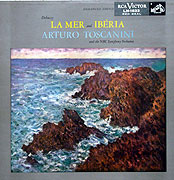  who in 1909 became one of the first conductors to program La Mer (and for whom it became a favorite work, as he played it during his American years more often than any other composition, including his famed Beethoven and Brahms). As a measure of their mutual respect, Debussy agreed to some refinements Toscanini suggested in the scoring (including, in the first movement, doubling the divided cello passage with violas and adding trumpets to the final climax). Of his two studio recordings, the 1942 Philadelphia (BMG CD) boasts that orchestra's smooth, mellow, rich sound, while the 1950 NBC Symphony (BMG) glistens with clarity and detail and bursts with vitality. We also have four concert recordings that round out our portrait of the conductor who seems closest to Debussy's own aesthetic but whose studio efforts tend to be more brittle than his humanistic live work – 1935 with the BBC Symphony (with full dynamic range, textural clarification and old-fashioned portamento in the solo violin, EMI), 1936 with the New York Philharmonic (less dramatic and a lighter touch, Music and Arts), 1940 with the NBC (impulsive and volatile, Naxos) and 1953 with the NBC (graceful, Arkadia). who in 1909 became one of the first conductors to program La Mer (and for whom it became a favorite work, as he played it during his American years more often than any other composition, including his famed Beethoven and Brahms). As a measure of their mutual respect, Debussy agreed to some refinements Toscanini suggested in the scoring (including, in the first movement, doubling the divided cello passage with violas and adding trumpets to the final climax). Of his two studio recordings, the 1942 Philadelphia (BMG CD) boasts that orchestra's smooth, mellow, rich sound, while the 1950 NBC Symphony (BMG) glistens with clarity and detail and bursts with vitality. We also have four concert recordings that round out our portrait of the conductor who seems closest to Debussy's own aesthetic but whose studio efforts tend to be more brittle than his humanistic live work – 1935 with the BBC Symphony (with full dynamic range, textural clarification and old-fashioned portamento in the solo violin, EMI), 1936 with the New York Philharmonic (less dramatic and a lighter touch, Music and Arts), 1940 with the NBC (impulsive and volatile, Naxos) and 1953 with the NBC (graceful, Arkadia).
Others who followed Toscanini's lead include Ernest Ansermet, who also consulted with the composer and obtained his consent on details of orchestration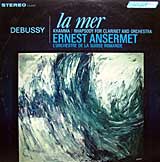 (but only toward the end of Debussy's life when, sapped by his final illness, he may no longer have cared). Ansermet's recordings of La Mer, all with his Orchestre de la Suisse Romande, (1948, Lys; 1957, Decca; and 1964, London LP) are strikingly similar, each reflecting through clarity and logic his training as a mathematician and, emanating from neutral Switzerland, his eclectic and transparent approach to music. Toscanini's protégé Guido Cantelli, whose 1954 Philharmonia recording (Testament) is precise and clear, is a bit warmer, with an overly-prominent glockenspiel the only bizarre feature. RCA gave Fritz Reiner and the Chicago Symphony (1960, BMG) a recording in which every detail of the instrumentation emerges with startling clarity, but perfection has its cost – his first movement is so deliberate as to seem calculated, mechanical and lifeless. Extraordinary detail is taken to the extreme in a 2003 concert by Claudio Abbado and the Lucerne Festival Orchestra (DG), in which the excitement of seeming to be in the middle of the players' frenetic activity is tempered by some bizarre balances, including fiercely chattering winds in the middle movement and curiously silent brass that obscures the theme of the massive climax of the first. (but only toward the end of Debussy's life when, sapped by his final illness, he may no longer have cared). Ansermet's recordings of La Mer, all with his Orchestre de la Suisse Romande, (1948, Lys; 1957, Decca; and 1964, London LP) are strikingly similar, each reflecting through clarity and logic his training as a mathematician and, emanating from neutral Switzerland, his eclectic and transparent approach to music. Toscanini's protégé Guido Cantelli, whose 1954 Philharmonia recording (Testament) is precise and clear, is a bit warmer, with an overly-prominent glockenspiel the only bizarre feature. RCA gave Fritz Reiner and the Chicago Symphony (1960, BMG) a recording in which every detail of the instrumentation emerges with startling clarity, but perfection has its cost – his first movement is so deliberate as to seem calculated, mechanical and lifeless. Extraordinary detail is taken to the extreme in a 2003 concert by Claudio Abbado and the Lucerne Festival Orchestra (DG), in which the excitement of seeming to be in the middle of the players' frenetic activity is tempered by some bizarre balances, including fiercely chattering winds in the middle movement and curiously silent brass that obscures the theme of the massive climax of the first.
A different, yet presumably authentic, interpretive tradition is heard in the very first recording of La Mer.  Debussy was fiercely proud of his national heritage, and referred to himself as "musicien français." Although born and trained in Italy and with a cosmopolitan career, Piero Coppola took charge of the French subsidiary of HMV, the dominant record company, for which he led pioneering recordings of Debussy, Ravel and many other French contemporaries that were acclaimed in their day as thoroughly idiomatic and often definitive. His 1932 La Mer (Lys, actually a re-recording of a 1926 version) is with the Orchestre de la Société des Concerts du Conservatoire, a mouthful of a name, but considered the preeminent French ensemble of the time. Perhaps due to the recording quality, textural details tend to blur, dynamics are attenuated and the harp is mostly inaudible. Yet, while tempos and accents depart considerably from the score (the "retenu" at the hub of the first movement is ignored), the pacing seems instinctive. At under 21 minutes, it's the quickest reading on record, yet there's a magnificently blended, relaxed, natural feeling of organic cohesion and unforced propulsion throughout. Debussy was fiercely proud of his national heritage, and referred to himself as "musicien français." Although born and trained in Italy and with a cosmopolitan career, Piero Coppola took charge of the French subsidiary of HMV, the dominant record company, for which he led pioneering recordings of Debussy, Ravel and many other French contemporaries that were acclaimed in their day as thoroughly idiomatic and often definitive. His 1932 La Mer (Lys, actually a re-recording of a 1926 version) is with the Orchestre de la Société des Concerts du Conservatoire, a mouthful of a name, but considered the preeminent French ensemble of the time. Perhaps due to the recording quality, textural details tend to blur, dynamics are attenuated and the harp is mostly inaudible. Yet, while tempos and accents depart considerably from the score (the "retenu" at the hub of the first movement is ignored), the pacing seems instinctive. At under 21 minutes, it's the quickest reading on record, yet there's a magnificently blended, relaxed, natural feeling of organic cohesion and unforced propulsion throughout.
Among those who followed the Coppola way was Pierre Monteux, who worked extensively with Debussy in 1912 while conductor of the Ballet Russes to prepare the world premiere of his final orchestral work, Jeux. 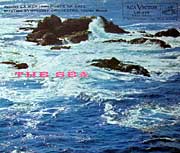 Monteux recalled that the composer would get upset with performers who tended to obscure the power and detail of his music in a delicate haze. Monteux's 1954 Boston Symphony recording avoids that pitfall, as it's bright and assertive yet typical of the conductor's self-effacing manner. Other French-trained conductors who follow suit include Jean Martinon, whose full-blooded 1984 reading with the Orchestre National de l'O.R.T.F. (EMI) boasts exceptionally smooth transitions and subtle gradations; and Charles Munch, whether performing with Coppola's orchestra (1942, Lys), transplanted to Boston (1954, BMG) or repatriated with the Orchestre National de France (1962, Valois); the latter, leisurely yet sharp, achieves an extraordinarily tense balance of delicacy and impulse. And speaking of cultural transplants, the most fascinating is Paul Paray, a quintessentially French conductor who transformed the Detroit Symphony into a quintessentially French ensemble. Their 1955 La Mer (Mercury) is elegant, crisp, richly detailed and thoroughly engrossing. Monteux recalled that the composer would get upset with performers who tended to obscure the power and detail of his music in a delicate haze. Monteux's 1954 Boston Symphony recording avoids that pitfall, as it's bright and assertive yet typical of the conductor's self-effacing manner. Other French-trained conductors who follow suit include Jean Martinon, whose full-blooded 1984 reading with the Orchestre National de l'O.R.T.F. (EMI) boasts exceptionally smooth transitions and subtle gradations; and Charles Munch, whether performing with Coppola's orchestra (1942, Lys), transplanted to Boston (1954, BMG) or repatriated with the Orchestre National de France (1962, Valois); the latter, leisurely yet sharp, achieves an extraordinarily tense balance of delicacy and impulse. And speaking of cultural transplants, the most fascinating is Paul Paray, a quintessentially French conductor who transformed the Detroit Symphony into a quintessentially French ensemble. Their 1955 La Mer (Mercury) is elegant, crisp, richly detailed and thoroughly engrossing.
Among the pioneer recordings, Serge Koussevitzky and his Boston Symphony (1939, Pearl) present a third approach, trading the objectivity of Toscanini and the smooth, natural flow of the French for volatile personality.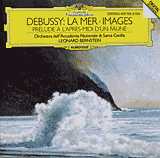 Others who have conducted La Mer to a different drummer include Dmitri Mitropoulos, whose 1960 Koln Radio Symphony concert (Arkadia) develops palpable tension through rhythmic irregularity; Evgeni Mravinski, whose 1962 Leningrad Philharmonic concert (Russian Disc) is intensely sharp and brittle, creating a fearsome portrait with blaring brass and shrill winds; and Leonard Bernstein, whose deeply impassioned 26½ minute La Mer with the Orchestra dell'Accademia Nazionale di Santa Cecilia (DG) finds the slowest tempo possible to highlight the components without risking structural dissolution. Others who have conducted La Mer to a different drummer include Dmitri Mitropoulos, whose 1960 Koln Radio Symphony concert (Arkadia) develops palpable tension through rhythmic irregularity; Evgeni Mravinski, whose 1962 Leningrad Philharmonic concert (Russian Disc) is intensely sharp and brittle, creating a fearsome portrait with blaring brass and shrill winds; and Leonard Bernstein, whose deeply impassioned 26½ minute La Mer with the Orchestra dell'Accademia Nazionale di Santa Cecilia (DG) finds the slowest tempo possible to highlight the components without risking structural dissolution. 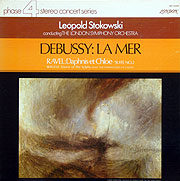 The slowest of all recordings – 33 minutes! – is (of course) by Sergiu Celibidache, who follows his relatively normal 1948 (Music and Arts) and 1980 (Artists Live) concerts with a 1992 Munich Philharmonic essay (EMI) completely devoid of emotional resonance, neither brooding nor monumental as the pace would suggest, but instead focusing entirely upon the mechanics, which emerge more lethargic than meditative. The slowest of all recordings – 33 minutes! – is (of course) by Sergiu Celibidache, who follows his relatively normal 1948 (Music and Arts) and 1980 (Artists Live) concerts with a 1992 Munich Philharmonic essay (EMI) completely devoid of emotional resonance, neither brooding nor monumental as the pace would suggest, but instead focusing entirely upon the mechanics, which emerge more lethargic than meditative.
The most startling and extraordinary recording is from Leopold Stokowski and the London Symphony (1965, Decca), who turn Debussy's ellipses into exclamation points through exaggerated dynamics (abetted by close miking and lots of help from the mixing board), deviant balances (harps that overwhelm the rest of the ensemble), lurching between extreme tempos and a Mahler-sized spine-tingling final climax. The result is surely not idiomatic Debussy but perverse in a wonderful way. Its marvelous playing, garish color, massive suspense, tangible atmosphere and striking drama are daring, compelling – and a huge dose of fun.
The biographical facts in this article largely were derived from Victor Seroff's Debussy, Musician of France (Putnam 1956) and Leon Vallas's Claude Debussy – His Life and Works (Oxford, 1933, reprinted by Dover, 1973). The latter contains a wealth of critics' commentaries (and, alas, a well-intentioned but frustratingly useless catalog of his work that provides the first line of each score that often ends before the theme enters). The liner notes to the various LPs and CDs contain much useful and stimulating commentary by the authors cited. The performance history of La Mer is traced by Michael Stegemann in his introduction to the Eulenberg miniature score. Debussy's own aesthetics and influences are best derived from his own writing, collected posthumously as Monsieur Croche, the Dilettante Hater (1921, reprinted by Dover, 1962). Influences are also traced in the article by François Lesure in Grove's Dictionary of Music and Musicians (2001).

Copyright 2006 by Peter Gutmann
|
